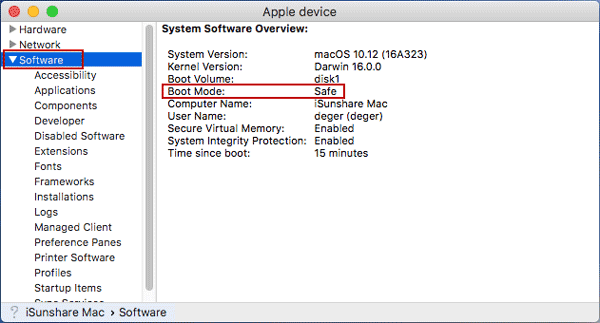
/article-new/2020/12/login-items.jpg)
- Mac restart to safe mode install#
- Mac restart to safe mode update#
- Mac restart to safe mode password#
- Mac restart to safe mode mac#
Mac restart to safe mode mac#
The Command+R shortcut helps while installing the latest macOS version you had on your Mac before the issue came up. There are different key combinations to use at startup, depending on what you want to do with Recovery Mode. Before you quit, you can choose a different startup disk from the Apple menu. Step 4: Exit Recovery Mode by going to the Apple menu and click Restart or Shut Down. There are extra utilities, including Network Utility, Startup Security Utility, and Terminal in the Utilities menu from the menu bar. Here, you’ll see the four services that Recovery Mode offers: Restore from Time Machine backup, Reinstall macOS, Get Help Online, and Disk Utility. Step 3: If you’re seeing the macOS Utilities window, it means startup is complete.
Mac restart to safe mode password#
Enter a password (user admin or firmware password) of the Mac if prompted to and move to the next step. Step 2: When you see the Apple logo, spinning globe, or any other startup screen, release the Command and ‘R’ keys. While it starts, hold down the Command and ‘R’ keys to enter Recovery Mode. Step 1: Boot into Recovery Mode by shutting down your Mac, and then restarting it.
Mac restart to safe mode install#
Perform a clean install of macOS to fix any issues that slow it down.Use Disk Utility to perform repairs when there are issues with your disk, or the Disk Utility tool couldn’t repair issues with your drive.Troubleshoot issues like startup failures.Recovery Mode allows you to wipe it and remove all your data and Apple ID. Wipe your computer to pass it on or sell it.You may never need to use it unless you want to do the following: It contains the latest macOS version you have installed, so you can troubleshoot any issues with your computer. The Recovery Mode tool made a debut with OS X 10.7 Lion in 2010. Get Help Online: This feature lets you use Safari to fix any internet connection or other issues you have with your computer.Before using it, upload your files to iCloud or other storage, and then reinstall the OS. Reinstall macOS: This feature wipes the current OS and its data, replacing it with a clean version.It’s a faster and more convenient method compared to erasing and reinstalling your computer. Disk Utility: This feature scans, verifies, and repairs your drives from the recovery screen in case something is wrong.Restore from Time Machine Backup: Time Machine copies all your files, OS, and settings, which you can then copy to an external hard drive and use it to restore your Mac’s data.Mac Recovery Mode comes with four main features: If you can’t recover your computer using other means, then Recovery Mode comes handy when diagnosing disk problems, installing the previous macOS that ran on your Mac, or getting help online. The recovery tools are loaded from a special disk partition holding a recovery image and copy of the macOS installer. Mac Recovery Mode is a special mode in macOS that loads native recovery tools that help you restore from a Time Machine backup, get help online, reinstall macOS, or erase a hard disk, and more.
Mac restart to safe mode update#
To do that, open the Apple menu, go to System Preferences, pick the Software Update option, and select Update Now.We’re going to explain what the macOS Recovery Mode is and the necessary steps for using it when diagnosing and fixing any issues, or reinstalling the macOS completely.

If you have issues updating your Mac normally, try doing that in Safe Mode. Newer system software updates for the Mac contain bug fixes and performance enhancements. If that doesn’t help, re-enter Safe Mode and work your way through the suggestions below. It’s best to follow it by immediately restarting the device in regular mode. Most of the time, booting into Safe Mode is enough to fix issues caused by minor disk errors, an obsolete system cache, corrupt fonts, etc. If you don’t see Safe Boot in red to the top-left of the screen, turn off your Mac and try again.

Then, press and hold down the Power button until the Startup Options screen appears. Turn off your Mac or press and hold the Power button to initiate a force shutdown.


 0 kommentar(er)
0 kommentar(er)
